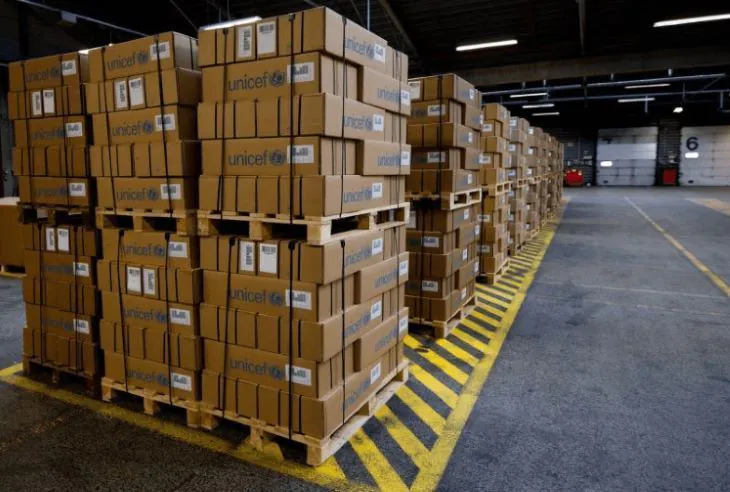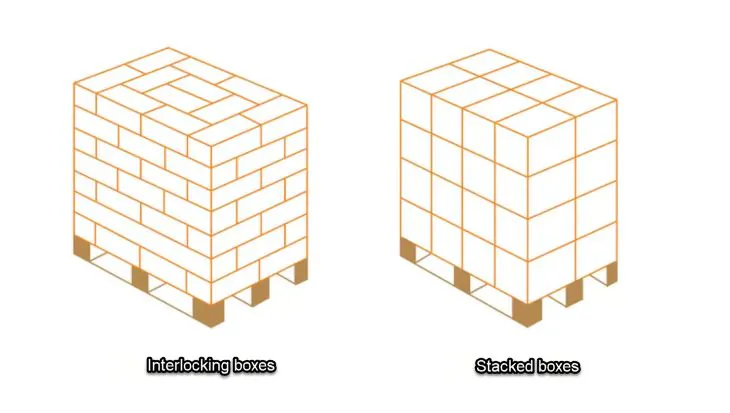Column stacking vs. interlocking stacking
Welcome once again to our series of four articles on pallet stacking. In the first article, we talked about the best way to stack a pallet. In the second part of our series, we talked about the different patterns that exist for loading onto a pallet and how fundamental it is to correctly arrange the shipment to ensure its stability during transportation and storage, as well as minimize the risk of damage to the products.

Source: https://s3-eu-central-1.amazonaws.com/eurosender-blog/wp-content/uploads/2020/01/29094108/p2oeI-s.jpg
Now it is time to present the third part of our series where we will talk about the two most important types of stacking in the industry and their differences.
Column stacking and interlocking stacking are two common techniques for stacking boxes on a pallet. The main differences between the two techniques are presented below.
Stacked in columns
In column stacking, the boxes are placed in vertical columns on the pallet. This means that all boxes are aligned on top of each other, maximizing pallet space and facilitating movement with loading equipment. This method is especially useful when working with loads of uniform weight and size.
Interlocking / interlocking stacking
In interlocking stacking, the boxes are placed in a jigsaw-like arrangement, where the boxes fit into each other and are secured to create a stable and secure load. This method is especially useful when working with loads of different sizes or shapes, and can provide greater stability than column stacking.
Advantages and disadvantages
In general, both techniques have advantages and disadvantages depending on the specific needs of each load. Column stacking is faster and more efficient when working with uniform loads, but may have less stability than interlocking stacking. Interlocked stacking can provide greater stability and safety, but can be slower and require more skill and experience to perform.

To decide whether you should use a columnar or interlocking stacking pattern, here are the advantages and disadvantages of each type.
Advantages of column stacking
- It is faster and easier to perform than interlocking stacking.
- It allows for maximum utilization of pallet space, which can be especially useful when transporting large quantities of uniform goods.
- It is easier to handle using loading equipment, such as forklifts and pallet trucks, since the columns are straight and uniform.
Disadvantages of column stacking
- It may be less stable than interlocking stacking, especially when dealing with heavier and higher loads.
- If the boxes are not properly aligned, there may be gaps between the columns, which may affect the stability of the load.
- Not suitable for irregular loads or loads of different shapes and sizes.
Advantages of interlocking stacking
- It provides greater stability than column stacking, as the boxes are interlocked together, which helps prevent movement and falls.
- It is suitable for irregular loads or loads of different sizes, as the boxes fit together.
- It can be safer during transportation since the boxes are secured together.
Disadvantages of interlocking stacking
- It requires more skill and experience to perform correctly, as the boxes must fit perfectly together.
- It may be slower and require more time to complete than column stacking.
- This may result in less efficient use of space on the pallet since the boxes are not placed evenly
We know that many times, the pallet loading process is not the right one, and a lot of time is wasted thinking about the most optimal way to perform this process. EasyCargo has the opportunity to perform different loading options within different cargo spaces in just a few seconds. This will allow you to save time and money in your logistics operations.
You can be completely worry-free! Thanks to our video tutorials, you and your team will master it quickly, and the first shipment will be available within minutes. If you need expert advice, our team will be happy to help you.
Now that we have covered the most important differences between these two stacking methods, we can also understand the differences, defects, and virtues between one and the other. I invite you to read our next article where we will answer the question: How to stack mixed pallet boxes?
Don’t miss the last article in our four-part series on pallet loading!




